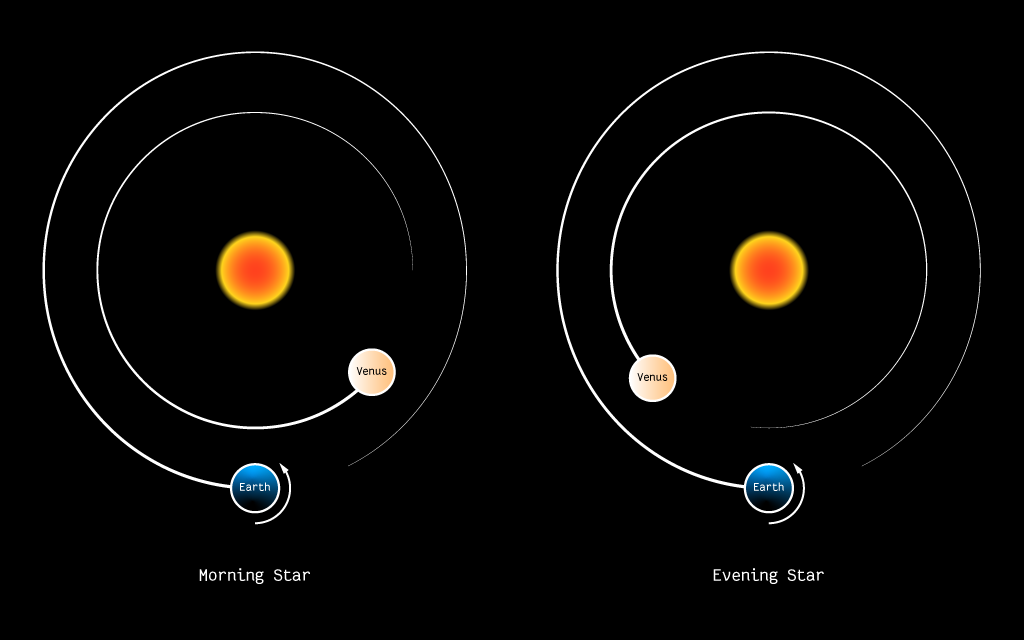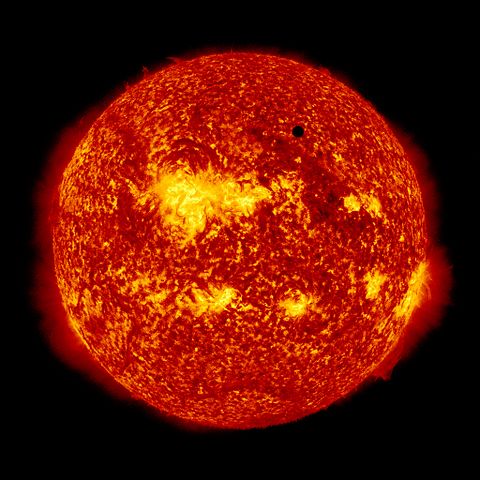Early on, before Suntime was called “Suntime” it was mostly the Sun and Moon graphed on a sine wave with some cool 3D waves. Andew was debating whether or not to add other celestial bodies to the scene. Memories are fuzzy now, but not long after having that thought someone at our weekly Board Game Night was playing with it and then asked “Hey, that’s cool… can I see Venus?” so there you go. We decided to add Venus.
It turns out I didn’t know much about Venus before it became a feature in the app. I knew it was a planet and that it was bright, but aside from that. Not much else.
When you fiddle with the app right now (it’s mid-June) you’ll notice that Venus appears briefly in the morning and then fades. I learned that depending on the time of year, Venus is actually either our morning OR our evening star!
It isn’t difficult to understand why we call it a “star” even though it’s a planet. Venus is the brightest thing in our sky after the sun and moon thanks to its highly reflective atmosphere and its proximity to Earth.
But what makes it the morning star?
Venus orbits the sun closer than we do. As we rotate away from the Sun towards outer space each evening, we are also turning our backs to Venus. This is why we can never spot Venus in the middle of the night: it’s close to where the Sun is.
To understand why Venus only appears near dawn or dusk, there’s a little bit of geometry to visualise. If we can imagine Earth and Venus as two runners on a track around the sun, Earth would be on the outer track, and Venus on the inner track, moving faster.
Because Venus is constantly lapping us, there are times in the year where Venus pulls ahead of us and we can see Venus “in front”, as well as times of the year where Venus is about to lap us, and can be seen coming up “from behind”.
As the Earth spins counterclockwise around its axis, we see the Sun rise in the east and set in the west. Whether Venus is “in front” of or “behind” the Sun changes the order in which we see it.

When Venus is ahead of us on the track, we see it “rising” in the morning before the Sun, and then disappearing as it gets outshone. By the time the Sun sets, Venus is already out of sight.
When Venus is behind us on the track, we see the Sun rise first. By the time Venus rises, the Sun is still too bright. As the Sun sets we see Venus, which appears as if it is setting in the evening after the Sun has gone down.
Because of this, we see Venus rise before the Sun when it pulls ahead of our orbit, disappear as it goes around behind the sun, and then reappear again as the evening star when it catches up to us from behind.
Perhaps cumbersome, but this is the best analogy I could come up with to explain it to myself.
Venus is also invisible to the naked eye when it crosses directly between Earth and the Sun. Although too bright to observe directly, pretty spectacular imagery of transits of Venus have been documented, as in 2012:

Its dual appearance as an evening star or morning star often caused Venus to be mistaken for two different bodies in religion and folklore. The Romans alternatively called the planet Lucifer, “light-bringer”, or Vesper, “evening”.
Venus’s dramatic fall from heaven forms the basis for many stories, including the Sumerian Inanna, Bablyonian Etana, Greek Phaethon, and in the Biblical Book of Isaiah.
For star-gazers, Venus has been rising in the predawn eastern sky since mid-June, and will continue to be visible in the early hours until next March. The planet will disappear as it starts crossing the Sun opposite to us, reappearing in the evening next May.
— Heather
Curiosity piqued?
See orbits in action: Solar system simulator in javascript
Another explanation of what the heck Venus is doing: Venus, the Morning Star in 2019
All about Venus on NASA
